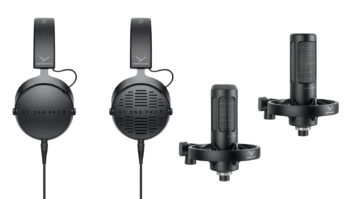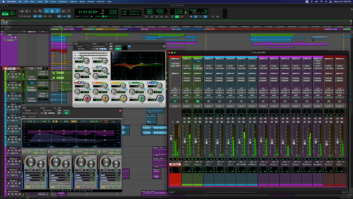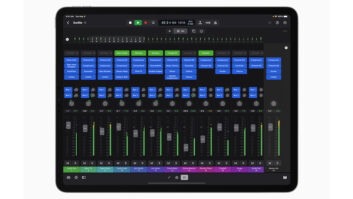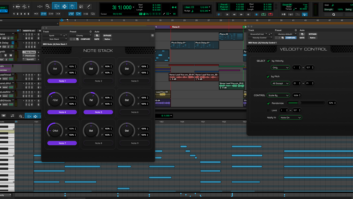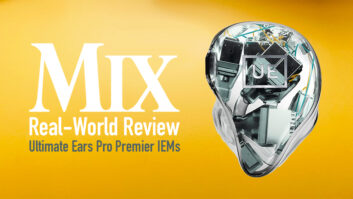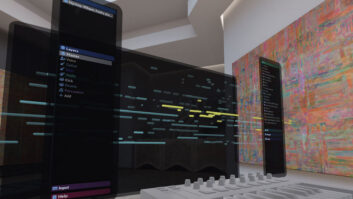In the 100 years between Thomas Edison’s invention of the phonograph in 1877 and the launch of Mix, recording and playback systems took gradual, incremental steps — some subtle, some bold. Then, in the late ’70s and early ’80s, digital technology blew open the door, and we’re still reeling from the backdraft. There has been more technological and entrepreneurial activity in the past 25 years than in the entire preceding century, and the next generation promises even more inventions, revisions, upgrades and detours than we’ve seen so far.
Any attempt to fix a date on the beginning of the digital era — or identify an individual or company responsible for ushering it in — is guaranteed to start an argument. There is no “father of digital audio” any more than there is any single entity that can claim credit for inventing it.
However, there were milestones in its development, some of which happened to coincide with the arrival of Mix in the fall of 1977. As we celebrate our 25th anniversary, we’ll reflect on the products, formats and trends that defined this fertile period in the history of recorded sound. We’ll also indulge ourselves a peek into the old crystal ball to see what the future may hold.
Leaving aside for a minute the recording industry, let’s take a snapshot of the technological landscape as it was in 1977. It’s easy for us now, freshly arrived in this era of connectivity, to recall that e-mail, the Internet and the personal organizer are relatively recent phenomena that were not even conceived of in the late ’70s — except maybe by crackpots whose views weren’t taken seriously.
But think about the other technologies we now take for granted that either didn’t exist or weren’t yet mainstream in 1977: cable TV, the remote control, the stereo Hi-Fi VCR, call-waiting, the answering machine, the fax machine, the personal stereo, the video game, the word processor, the personal computer, the CD player, the DVD player, GPS, home theater, MP3 and the cell phone — to name just a few.
In 1977, watching a television show meant sitting in front of your set at the appointed hour, adjusting a rabbit-ear antenna until the signal looked okay (it seldom looked “good”) and setting the volume at a comfortable level so you wouldn’t have to get up from your easy chair once the program started. The notion of taping a show to view later, or watching an R-rated movie at home — uncut by network censors or commercials — simply did not exist.
Similarly, listening to a record required a long attention span and a commitment to the task. You carefully plucked the LP from its sleeve to avoid getting fingerprints on it, wiped it with a cleaning solution if you cared about its health and that of your turntable, and gently placed the disc on the platter. Then you oh-so-delicately dropped the needle on the vinyl surface, cranked up a big rotary volume knob, sat down in a plush chair, and contemplated the cosmos as the music came blasting out of the speakers. You probably weren’t doing anything else while listening, other than gazing at the album cover and reading the liner notes.
Today, we seldom devote ourselves to any one task for more than a few minutes. Music gets listened to in the car, in a personal stereo at the gym, at our desks at work, or at home while cooking dinner, folding the laundry or browsing the Internet. Under such harried conditions, we almost never allow ourselves the luxury of actually listening to what we’re hearing. We live in a world in which our information and entertainment choices are so vast as to be overwhelming, and we owe this fragmentation, in part, to the power and versatility of digital media.
If consumer electronics have undergone a radical transformation in the past quarter century, so has the task of recording, editing and mixing music. If you were a session musician going into a studio to cut a track in the late ’70s, you almost certainly recorded onto an 8, 16 or 24-track analog reel through a console that had, at the most, 32 channels. There wouldn’t have been much outboard gear to speak of, other than the heavy-duty vintage pieces you still find at high-end studios throughout the world.
The process could not have been more straightforward. You played, you recorded, you listened back and you mixed — sometimes all in the same day. There was no timecode, no sampling rate, no tapes or drives brought in from home, no automation, no computer, no digital pops and clicks, no plug-ins, and there was little ability to time-shift or tune poorly played parts. What you saw was what you got, and what the listener heard on the other end was a reasonable re-creation of what went down in the studio, even if it was souped up by a creative engineer.
There were limitations on everything: the number of tracks on the tape machine, the amount of processing gear in the control room, the number of channels and auxiliary sends on the console, the ability to move from home to studio (or from studio to studio), the amount of time allotted to editing and mixing, etc.
Today, by contrast, we approach recording projects with a seemingly infinite palette of possibilites. We can leave a song in mid-stream and know that the next time we put it up on the drive or the digital console, it will come up exactly as we left it. We can clone tracks ad infinitum without worrying about generational loss. We can collaborate with musicians across the world via the Internet. We can avail ourselves to a powerful arsenal of editing, processing and mixing technology in the space of a computer hard drive.
Then, once we’ve finished the “album,” we can mix it down to DAT, MDM (bit-split or not), CD-ROM, audio CD, Exabyte, AIT, DLT, data DAT, Masterlink, SCSI drives, FireWire drives or various analog formats (half-inch being the most common, but quarter-inch and 1-inch are also viable). Heck, if we want to we can use all of those formats and more. (I’m sure I’m forgetting at least a couple.)
We can upload the master to an FTP site or convert it to a data-compressed format to deliver remotely for approval. Or, if we choose to overnight a “hard” copy to a collaborator far away, we can rest assured that if FedEx loses the package, the “original” master will not be lost, provided we went through the trouble of making a digital clone and/or data backup.
We’ve come a long way, baby, and we’re still going! But, you ask, how did we get here?
THE BIRTH OF DIGITAL AUDIO
You might be surprised to learn that the origins of digital audio can be traced as far back as 1937, when Alec H. Reeves, a scientist at the International Telephone and Telegraph Co. in France, invented pulse-code modulation. He was granted a French patent in 1938, a British patent in 1939, and U.S. patent No. 2,272,070 in 1942, according to Steve Schoenherr, a history professor at the University of San Diego.
Although Reeves set the foundation for PCM audio in the early 20th century, it wasn’t until 1962 that Thomas Stockham, an electrical engineering professor at M.I.T., began experimenting with digital audio tape recordings. Later, in 1975, he would co-found Soundstream, a company that created one of the first commercially available digital recorders.
At the same time, 3M engineer Tom Jung was also experimenting with PCM-based digital audio recording. He later left 3M to form DMP Records, which would become the first label to devote itself exclusively to the CD format.
Notwithstanding these important but relatively isolated experiments, the digital era began in earnest in the 1970s with various concurrent developments, including the digital delay, the microprocessor, the Synclavier synthesizer, the Apple computer, and videotape-based digital audio recorders.
We all know that the digital delay — introduced in 1971 by Gotham Audio and Lexicon — evolved into a universe of products synonymous with modern-day studio mixing. We also know that the Apple I launched a revolution in home computing that lives on in the form of the Macintosh. And, we are generally aware that New England Digital’s Synclavier set the stage for the digital synthesizers, samplers and tapeless studios of the ’80s and beyond.
But what happened to the early digital recorders, such as the multitracks from Soundstream, 3M and Mitsubishi, as well as Sony’s PCM-F1 processor, which allowed users to record 14- or 16-bit digital signals to Beta or VHS decks? For reasons that had as much to do with luck, marketing and timing as with technology, these pioneering units all ended up in history’s dust bin.
Much more fortunate were Sony’s 24-track DASH machine and PCM-1610 U-Matic mastering deck (along with its successor, the 1630). Whatever their limitations, those products took hold because they were perfect for their time.
The DASH format, only recently eclipsed by lower-priced modular digital multitracks and hard-disk recorders, was for a long time the only game in town when it came to studio recording. (True, 3M and Mitsubishi fared well with their 32-track digital recorders, but they did not achieve either the market penetration or longevity of the 24- and 48-track DASH.)
By the same token, the 1610 arrived at a time when the mastering and manufacturing sectors of the industry needed a solid, universal carrier for digital audio masters. The U-Matic kept its stranglehold on that market until more consumer-friendly formats like the CD-R came along.
COMPACT DISC: CONSUMERS TAKE THE WHEEL
Of course, no amount of professional digital production would have meant much without a digital consumer sound carrier like the compact disc. It’s impossible to overstate the impact of the CD. Of all the technologies that have appeared since the beginning of (audio) recorded history — analog or digital, consumer or professional — the little plastic disc is arguably the most successful.
While we in the audio world have preoccupied ourselves with comparing the 16-bit CD to high-end analog formats — and finding that the Red Book standard that underlies the CD is, at best, limited — the consumer’s perspective has been entirely different.
Take off your “industry” hat for a moment and remember what it was like to be a consumer in the LP era. You had to constantly worry about the quality and integrity of your turntable cartridge, lest a worn needle damage the grooves of your cherished records. And, if you borrowed a friend’s album to listen to it or tape it — or bought a used LP — how could you ensure that it wouldn’t damage your $75 needle? What about skips and scratches? Disparities in quality between the first and last tracks on a side? Differences between different pressings of an album? The wear and tear on the grooves after only a few spins?
Even sonically, the LP left a lot to be desired. Unless you could afford an audiophile system and were disciplined enough to play only pristine albums on it, you probably experienced lackluster sound compared to what the creators of the music were hearing in the recording studio. Any mastering veteran will tell you that vinyl records were limited in their ability to deliver to the home what they were hearing coming off the 1/4- or 1/2-inch master.
Given those limitations, it’s no wonder the public took to the CD like fish to water. After all, the new digital format was everything that the LP wasn’t: practical, compact, durable, sexy and new.
If the CD’s runaway success was impressive, its endurance has been downright staggering. No other product in the digital era has lasted, virtually intact, for 20 years and is still going strong. Barring an unexpected turn of events, the audio CD will remain the dominant sound carrier for a good decade or more, and its cousins — the CD-R, the CD-ROM, the photo CD, etc. — are equally poised to remain in the forefront well into the foreseable future.
CONNECTIVITY, AUTOMATION: MORE TRACKS!
As the CD was wowing the public at large in the early ’80s, digital processors, samplers, synthesizers and drum machines were transforming the recording studio. But for all their creative potential, these new devices would prove unwieldy unless they could be made to talk to one another.
Enter MIDI. A protocol that allowed all compatible digital instruments and modules to communicate with each other, MIDI was the solution for musicians, programmers and engineers who were struggling to make sense of their new digital arsenals. So powerful was the impact of MIDI on the recording industry that it colored the sound of music itself, giving rise to the synth pop sound of the early ’80s and other subsequent forms of electronic music.
The advent of MIDI — with its layers of real and “virtual” tracks — combined with the arrival of 48-track recording (via the second-generation, 48-track DASH and the ability to synchronize two or more analog 24-tracks) to usher in the age of the big consoles. No longer would 32 channels suffice to handle a music mix; studios had to think in terms of 56 channels or more if they had any hopes of capturing mixing work.
Whereas Neve had dominated the console market for the better part of the 1970s, Solid State Logic emerged as the leader in the early ’80s with its top-of-the-line 4000 E Series mixer. Its features and options included Total Recall, automation, built-in dynamics and processing, and extensive routing capabilities. In short, the SSL 4000 E was perfectly suited to the increasingly complex needs of recording and mixing engineers at the time.
By the late ’80s, a high-end commercial studio was expected to have a bank of MIDI-enabled synthesizers and drum machines; at least one and, ideally, several analog 24-tracks, along with a Time-line synchronizer; a Sony or Studer DASH 48-track; an automated SSL console (or a Neve, if the room was geared for tracking); a half-inch analog mastering deck; and a DAT machine, which by then had become the de facto digital mixdown medium after it failed to emerge as a recordable consumer sound carrier.
ENTER THE PROJECT STUDIO
While professional engineers and studio owners were busy sorting out a tangled web of new technologies, home recording enthusiasts were bubbling with excitement over the cassette multitrack recorders that had been introduced starting in the early ’80s by companies including Tascam and Yamaha, and by low-cost drum machines by the likes of Roland and Yamaha. Few knew it at the time, but the recording establishment and this burgeoning home-based market were on a collision course that would level the playing field for the entire industry in the next decade. However, before the home studio could pose a real threat to commercial facilities, the audiocassette would have to give way to a new, improved and preferably digital format.
The Alesis ADAT — a VHS-based, modular, digital 8-track recorder — turned out to be the dark horse on which the home recording army would ride to do battle with their big-studio rivals. Introduced in early 1991 at a NAMM show, the ADAT was an instant success.
Just as the CD had remedied the perceived shortcomings of the vinyl LP, the ADAT seemed to be the answer to every home recordist’s prayers. Its audio fidelity was considerably better than that of the cassette, it offered the ability to bounce tracks without losing quality, and its track capacity was virtually unlimited with the use of two or more machines in a modular setup. Furthermore, it was affordable — albeit more expensive than a cassette Portastudio.
Later, Tascam — the creator of the Portastudio — weighed in with the DA-88, a Hi-8-based machine that worked on the same principle as the ADAT but was a bit pricier and more professionally oriented. Together, these two devices — MDMs, as they came to be called (thanks to Mix editor George Petersen) — opened a floodgate for amateurs and professionals alike. Suddenly, a recording hobbyist with enough skill and creativity could make a master-quality record at home.
To further sweeten the pot for home-based engineers with modest budgets, in 1995 Yamaha introduced the 02R digital mixer, an automated console with built-in effects, dynamics and option cards that offered digital links to ADATs, DA-88s and other popular devices. Other companies followed with similar products, and suddenly a market was born for affordable digital mixers that interfaced with the huge installed base of MDMs.
While the MDM/digital mixer combination posed a clear threat to commercial studios, forward-thinking facility owners saw that the same technologies that were enabling the home studio could also save them money. In other words, inexpensive MDMs — or some future variant thereof — could replace a far costlier DASH mutitrack. Even if a studio owner felt he or she needed to stock a DASH machine for compatibility with the rest of the world, one recorder — not three — might suffice in a three-room facility.
Still, there was tension between these two ends of the recording spectrum, and it was far from the only source of friction in the recording industry in the 1990s.
A ROCKY ROAD TO DVD
In a format battle that recalled the Beta-vs.-VHS wars of the late ’70s, Sony and Philips went head to head in 1991 with rival digital consumer sound carriers that were intended to address the need for a recordable product. Sony’s MiniDisc (MD) and Philips’ Digital Compact Cassette (DCC) were introduced almost simultaneously and with much fanfare, but neither managed to hit its target.
The DCC — a tape-based medium that employed the same form factor as an analog cassette, allowing backward compatibility with that format — died a swift death and has hardly been heard from since. The MD, on the other hand, may have failed to make it as a consumer carrier, but it emerged as a viable product in the broadcast, data backup and home-recording markets (the latter in the form of 4-track units modeled after the successful cassette multitracks of the ’80s).
Interestingly, because of the data compression necessary to encode digital audio on a physically small carrier, MD and DCC were the first products ever introduced whose sound quality was admittedly inferior to that of its predecessors (i.e., the CD and DAT).
This dubious distinction set the tone for other consumer and professional digital audio products of the 1990s, some of which were marketed on the strength of their practicality and flexibility, not their sound quality. This was true of ADAT and DA-88 (no one claimed that those machines were sonically comparable to, say, a Sony 3348 DASH recorder), MP3 (its creators boasted “near-CD quality”), and DTS and Dolby AC3, lossy compression systems used to encode surround-audio streams in CDs and DVDs.
If the ’80s were dominated by such formats as MIDI, DASH, automated mixing and the CD, the ’90s brought about an even wider array of possibilities for consumers and pros alike.
Still basking in the glow of the CD boom — which created both excitement for new releases and a massive market for reissues — the record industry tried, unsuccessfully, to repeat the feat in the ’90s. Undaunted by the MD/DCC fiasco, in 1995 record labels introduced the enhanced-CD, a format that was saddled with technical hurdles, unwanted by the public, and was eventually made obsolete by the DVD.
Next, the record business set its sights on DVD-Audio. Here again, however, a series of tactical missteps and miscalculations have conspired against the format’s success, and to date, it has not taken off. The jury is still out on DVD-Audio, but it’s safe to say that, if it succeeds at all, if will take several years.
The first problem with DVD-Audio was that the record industry insisted on incorporating a counter-piracy system into the format, as it did with DAT in the late ’80s. While that effort may have been well-intended, it stalled the publication of the technical spec by a few critical years, during which DVD’s video counterpart got off to a running start.
Initially, DVD-Audio and DVD-Video were intended to be released simultaneously, with DVD hardware supporting both formats. However, when DVD Audio bogged down in political negotiations over piracy and other issues, DVD-Video did not wait. After a fitful start during which two opposing camps — led by Sony/Philips and Time Warner/Toshiba — vied for the standard, an agreement was hammered out to create a single DVD-Video format.
It was the best thing that could have happened to DVD-Video, judging by a market introduction in the mid-to-late-’90s that justifiably earned comparisons to the CD. And no wonder, since DVD-Video was for the VHS user what CD was for the record buyer: a panacea.
But back at the audio ranch, things weren’t going so well. While millions of DVD players were being sold to home video users, not a single one had a DVD-Audio chip in it, because the DVD-Audio spec had yet to be written. This was a lost opportunity from which the music industry has yet to recover.
When the DVD-Audio spec was finally published in 1999, it delivered on its promise of higher-resolution digital audio in both the stereo and multichannel domains (the latter thanks to a loss-free compression system developed by Meridian Audio). However, consumers did not appear to be interested in replacing their beloved CDs. The viewpoints of many audio professionals notwithstanding, the average consumer did not — and does not — feel the sound of CDs is in any way limited.
Furthermore, some marketers of music-oriented DVD-Videos touted their titles’ superior audio capabilities vis-a-vis CD, further perplexing a consumer base already bombarded with an overabundance of formats. To this day, some seven years after the notion of DVD was introduced to the public, most people still have no idea what DVD-Audio is or why they should be interested in it.
To make matters even more confusing, Sony and Philips launched Super Audio CD, yet another high-resolution, disc-based audio format, but one that employs the Direct Stream Digital encoding process, which is inherently different from the linear-PCM system that underlies the vast majority of digital audio devices.
As with DVD-Audio, Super Audio CD has met with only limited success, mostly from audiophiles who are equipped to appreciate its superior sound. For the mainstream music consumer, however, both formats remain irrelevant.
TODAY’S STUDIO-IN-A-BOX
While the label side of the business grappled with the DVD/SACD conundrum, the production community became consumed in another trend that rewrote many of the rules of the industry: the digital audio workstation.
Initially embraced by mastering engineers as a 2- or 4-track, 16-bit editing platform, the DAW evolved into a bonafide tracking/mixing tool with the advent of 24-bit recording, powerful computers like the Mac G3, and a third-party plug-in architecture that provided a wealth of processing options without any additional hardware.
Although many companies marketed compelling DAWs, Digidesign’s Pro Tools platform became — and remains — the leader starting with the introduction of Pro Tools 24 in the late ’90s.
Initially resisted by large pockets of the music recording universe, DAWs became increasingly visible at the turn of the millennium, and by now they’re nearly ubiquitous.
Because of their inherent versatility as recorders, editors and processors, DAWs have carved huge holes into the demand for linear digital audio recorders like MDMs and DASH machines, digital consoles of the 02R generation and hardware processors. Up until a few years ago, a credible studio needed a minimum of two or three MDMs, a good console, and a stack of outboard gear. Today, a $2,500 G4 equipped with a $1,000, entry-level Pro Tools Digi 001 could form the core of a serious home studio that could give a commercial facility a run for its money, at least in the overdubbing and editing aspects of production.
Besides reducing costs — and thereby further threatening the commercial studio business — the consolidation of the home studio in a computer opens up the possibility of the Internet studio, a hot trend that is likely to define the next era of recording.
With the studio computer linked to the Internet via a high-speed connection, one can now collaborate with other music makers throughout the world by simply posting tracks on a server, or conceivably e-mailing them back and forth. This method of transmitting audio through cyberspace works equally well for shared multitrack projects as it does for quick approval of mixes or other works in progress. It’s a big world out there, but it’s being made smaller by the connectivity that these tools afford us.
THE NEXT WAVE
So, where does all this power, all this flexibility, and all this inter-connectedness leave us as members of the music production community?
For all we’ve accomplished in the past quarter century, we have probably only scratched the surface of what we can accomplish from a technical, creative and entrepreneurial perspective.
The home theater promises to open new vistas for musicians, audio engineers, and business people as we try to figure out how to maximize the format’s potential. So far, we have dabbled in surround audio production, but the vast majority of our collective experience remains in the stereo realm.
We have raised the bar of audio resolution to a nominal threshold of 24 bits and 192kHz sampling, easing the concerns of those who felt that early digital sound was “cold.” It’s getting warmer, but it’s still not as hot as a live performance. How can we make our recordings sound more “real”? Do we increase the word length? Do we embrace a whole new paradigm of digital recording, as Direct Stream Digital is trying to do? Or is there another, still uninvented way of delivering music to the listener?
We are beginning to use the Internet to further our creative goals, but even with T1s, DSL and cable modems, our ability to upload and download uncompressed audio data is severely limited by those systems’ available bandwidth. If we are to truly rely on the Internet as a production tool, we need wholesale increments in bandwidth and affordable access to it.
Ultimately, even if we harness all these tools to their full potential, our success as creative individuals will be measured not by our technical achievements, but by how deeply we touch people with our work. As music industry veteran Al Teller wrote in 1991: “While we may be dazzled by all this technical wizardry, we should not be blinded to a simple truth: that it still takes the talents of a gifted artist to make these instruments truly sing.”
Paul Verna is Mix magazine’s New York editor.
